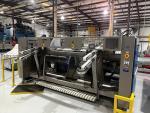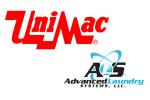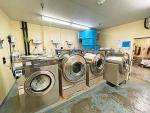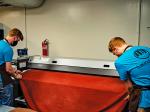CHICAGO — Upgrades are a constant in the laundry and linen services industry.
Some operations need to improve quality and efficiency. Others have acquired older facilities in desperate need of upgrades.
Sometimes equipment simply wears out.
Costs, labor issues, government regulations … there are many reasons for industrial laundries to update equipment and facilities.
American Laundry News reached out to several laundry operators and equipment manufacturers to find out which upgrades have been requested most recently, the reasons for the upgrades and how operations have been improved.
MANUFACTURER OBSERVATIONS
Consolidations within the industrial laundry market space have become prevalent as companies strive to optimize efficiency and streamline operations, shares Cliff Quick, director of inside sales and project management for G.A. Braun Inc. in Syracuse, New York.
“Large industrial laundry processors are increasingly acquiring smaller companies’ industrial facilities, which often brings forth the need to upgrade and retool older equipment with newer technology and automation,” he points out.
“In many situations, modernizing equipment is not simply an option but a strategic necessity. Aging equipment poses several challenges such as higher maintenance costs, increased risk of downtime and lower productivity.
“Newer and more advanced systems offer features such as predictive maintenance, real-time monitoring and data analysis, providing companies the ability to proactively address issues, optimize resource allocation and maximize throughput.
“Automation helps to reduce labor dependence and ensures consistent quality.”
Quick points out that in some instances, consolidations will require facility expansion or renovation/retooling, adding that these types of projects are the most complex given the need to maintain levels of production during project implementation activity.
In some cases, a compromise must be made between supporting existing processing requirements and the project implementation.
“At Braun, we understand these unique challenges and partner with our clients to execute equipment installation projects in the safest and most cost-efficient manner,” he shares.
“Braun’s approach to integrated project management is constantly leveraged to establish and maintain project schedules in accordance with the agreed-upon objectives and set forth by the end-user client partner.
“Braun project management has the capability to coordinate the equipment delivery and freight loading plan to coincide with the rig-out of the existing equipment and the off-loading of the new equipment. Braun’s expertise in equipment rigging is always key given many retooling activities have aggressive timelines for project execution.
“In addition to collaborating with customers to support the equipment rigging activities, Braun highly recommends that an experienced third-party MEP (mechanical, electrical, plumbing) contractor be involved in executing the equipment utility systems installation.
“The MEP contractor needs to be responsible for reviewing and validating the existing utility systems to make certain all were sized accordingly to support the requirements of the new equipment.”
Quick says that to ensure a plant did not experience lost production during a recent upgrade, work was completed during off-shift hours as well as on weekends.
“The Braun Project Management Team will work with the client and contracted trades to prepare and provide all the equipment specifications as well as the utility connection overlay,” he says. “This will in most cases be for the MEP contractor to complete pre-fabrication of materials to support the installation in advance to expedite the schedule.
“All the coordination and planning, including project meeting sessions on-site as well as via teleconference, resulted in a safe and effectively executed retool of the laundry.”
Automation and new equipment significantly improved transfer times, quality and capacity resulting in greater efficiency with less labor, according to Quick.
“That, in turn, enabled our customers to boost production to meet current and future demands,” he points out.
“In a recent new wash alley upgrade, we increased washer capacity by replacing older 400-pound open pocket washers with the newer and narrower N2 design, allowing the customer to add additional washers in the same footprint.
“Furthermore, as an additional measure of safety, the new washers are chute-loaded by a rail system. The system now operates without dedicated employees inside the wash alley.”
Jenny Repfennig, regional marketing manager, NAM region, for Miele Professional based in Princeton, New Jersey, says the commercial laundry industry has seen several key trends and popular upgrades in recent years, driven by the need to increase efficiency, reduce environmental impact and enhance operational effectiveness.
“We are constantly seeking input from our customers and partners,” she says. “There has been a significant shift toward energy-efficient models that consume less water and electricity. This not only helps in reducing operational costs but also aligns with the growing emphasis on sustainability.”
Equipment that can perform multiple tasks (e.g., wash and extract) in one cycle is increasing in popularity, shares Repfennig. Upgrading machines with advanced control systems allows for more precise control over laundry processes.
This might include the development of customizable programs for different types of fabrics, which can lead to better cleaning results and fabric care, as well as energy savings.
“Miele is addressing these needs and others with the introduction of our new line of Benchmark washers and dryers, designed and engineered for on-premises laundry operations,” Repfennig says.
“Engineered for high throughput and trusted durability, Benchmark on-premises laundry provides hotels, hospitals and other facilities with reliable, onsite textile and linen reprocessing.”
She adds that Benchmark laundry is also engineered for sustainable performance and maximum fabric longevity.
Overall, there’s always a desire to enhance operations, Repfennig points out.
“Whether it’s laundry operators or facility managers in a hotel or a hospital, there is a desire to find ways to decrease machine downtime and increase operational efficiencies,” she says.
“Facilities professionals are more aware today that addressing back-of-house operational improvements can result in an improved bottom line and a better experience for their guests or patients—or whomever else is using their linens.
“Aiming to lower costs, facilities managers and laundry professionals are realizing that with the right machines, they can maintain their linens for longer without service fees or replacement costs associated with alternative machines or third-party services.
“And above all, most managers want to know their investments in laundry solutions are helping to achieve sustainability goals—using less water, energy and detergents when possible.”
Miss Part 1 with laundry operator upgrades? Click HERE to read it.
Check back Tuesday for the conclusion with upgrade stories from four more manufacturers.
Have a question or comment? E-mail our editor Matt Poe at [email protected].

























